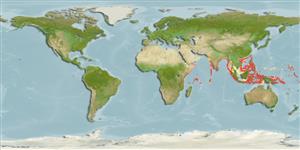ກຸ່ມປາກະດູກອ່ອນ (ເຊັ່ນ: ປາສະຫລາມ, ປາຜາໄລ) (sharks and rays) >
Carcharhiniformes (Ground sharks) >
Proscylliidae (Finback catsharks)
Etymology: Eridacnis: Etymology not explained, possibly eri-, Greek intensive particle (i.e., very), and dakno (Gr.), bite, referring to “wide, angular” mouth of E. radcliffei. (See ETYFish); radcliffei: In honor of ichthyologist-malacologist Lewis Radcliffe (1880-1950), scientific assistant of the U.S. Bureau ofFisheries and member of team that collected holytype from aboard the fisheries steamer Albatross. (See ETYFish).
More on author: Smith.
Environment: milieu / climate zone / depth range / distribution range
ນິເວດວິທະຍາ
ສັດທະເລ ກ່ຽວກັບ(ຢູ່)ຊັ້ນນ້ຳໃນທະເລທີ່ເໜີອພື້ນດິນ; ລະດັບຄວາມເລິກ 71 - 766 m (Ref. 10004). Deep-water; 22°N - 10°S
Indo-West Pacific: widely distributed but with spotty records from Tanzania, the Gulf of Aden, India (Gulf of Mannar, Bay of Bengal), Andaman Islands, Viet Nam, and the Philippines. The immense range of this species is striking compared to the limited ranges of other members of the genus.
Length at first maturity / ຂະໜາດ / ນ້ຳໜັກ / Age
Maturity: Lm 15.5, range 15 - 16 cm
Max length : 23.0 cm TL ຕົວຜູ້/ບໍ່ມີເພດ; (Ref. 244); 24.0 cm TL (female)
ຄີ (ໜາມ)ແຂງຢູ່ຫຼັງປາ (ທັງໝົດ): 0; ຄີຫຼັງຂອງປາ (ຄີອ່ອນ) (ທັງໝົດ): 0; ຄີ(ໜາມ) ແຂງຢູ່ຄີກົ້ນປາ
ກຸ່ມປາກະດູກແຂງ
ຄວາມຖີ່ຂອງກຸ່ມຖ່າຍທອດພັນ
ປາທີ່ມີການເຄື່ອນຍ້າຍຈາກທະເລໄປຫານ້ຳຈືດ ແລະນ້ຳຈືດຫາທະເລ
ປາທີ່ມີການເຄື່ອນຍ້າຍຈາກທະເລແລະໄປໄຂ່ຢູ່ນ້ຳຈືດ
ຄີກົ້ນຂອງປາ
ສັດທີ່ມີກະດູກສັນຫັຼງ
ການຖ່າຍທອດທາງກຳມະພັນຈາກພໍ່ແມ່ຫາລູກ 0; ຄີກົ້ນຂອງປາ: 0. Caudal fin without a rippled dorsal margin and ventral lobe but with a strong subterminal notch; vertebral axis of caudal fin little raised above body axis (Ref. 13566). Dark brown with blackish markings on dorsal fins (Ref. 13566).
Occurs over muddy bottoms, on the upper continental and insular slopes and outer shelves (Ref. 244). Feeds mainly on small bony fishes and crustaceans, with squid a lesser item in the diet (Ref. 244). One of the two smallest living sharks (Ref. 13566). Ovoviviparous (Ref. 50449), with 1 to 2 pups in a litter (Ref. 244).
Ovoviviparous, embryos feed solely on yolk (Ref. 50449). 1-2 pups per litter, size at birth about 11 cm (Ref. 244).
Compagno, L.J.V., 1984. FAO Species Catalogue. Vol. 4. Sharks of the world. An annotated and illustrated catalogue of shark species known to date. Part 2 - Carcharhiniformes. FAO Fish. Synop. 125(4/2):251-655. Rome: FAO. (Ref. 244)
IUCN Red List Status (Ref. 130435)
Human uses
ຂໍ້ມູນຕື່ມອີກ
ເອກະສານອ້າງອີງການລ້ຽງສັດນ້ຳຂໍ້ມູນການລ້ຽງສັດນ້ຳສາຍພັນກຳມະພັນElectrophoresesການຖ່າຍທອດທາງກຳມະພັນຈາກພໍ່ແມ່ຫາລູກພະຍາດການປຸງແຕ່ງNutrientsMass conversion
ຜູ້ຮ່ວມມືຮູບStamps, Coins Misc.ສຽງຫອຍມີພິດຊະນິດນຶ່ງທີ່ອາໄສໃນທະເລຄວາມໄວປະເພດການລອຍເນື້ອທີ່ເຫືອກOtolithsສະໝອງວິໄສທັດ
ເຄື່ອງມື
Special reports
Download XML
ແຫຼ່ງອີນເຕີເນັດ
Estimates based on models
Preferred temperature (Ref.
123201): 9.3 - 18.6, mean 12.7 °C (based on 254 cells).
Phylogenetic diversity index (Ref.
82804): PD
50 = 0.6328 [Uniqueness, from 0.5 = low to 2.0 = high].
Bayesian length-weight: a=0.00389 (0.00180 - 0.00842), b=3.12 (2.94 - 3.30), in cm total length, based on all LWR estimates for this body shape (Ref.
93245).
ຊັ້ນເຂດຮ້ອນ (Ref.
69278): 4.1 ±0.3 se; based on diet studies.
ຄວາມຢືດຢຸ່ນ (Ref.
120179): ຕຳ່ຫຼາຍ, ປະຊາກອນຕຳ່ສຸດທີ່ໃຊ້ເວລາສອງເທົ່າຫຼາຍກວ່າ 14 ປີ (Fec=1).
Fishing Vulnerability (Ref.
59153): Low vulnerability (14 of 100).
Nutrients (Ref.
124155): Calcium = 14.4 [2.4, 98.2] mg/100g; Iron = 0.371 [0.078, 1.303] mg/100g; Protein = 18.1 [16.0, 20.2] %; Omega3 = 0.235 [0.091, 0.594] g/100g; Selenium = 8.99 [2.70, 29.75] μg/100g; VitaminA = 35.1 [6.9, 180.5] μg/100g; Zinc = 0.462 [0.219, 0.922] mg/100g (wet weight);
